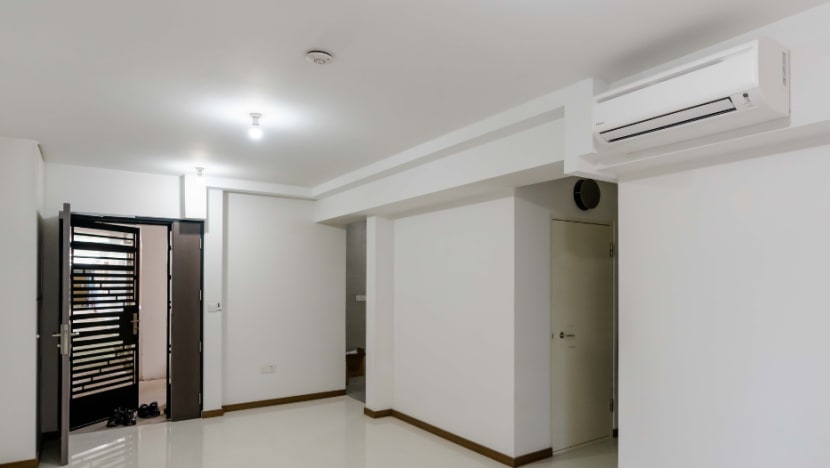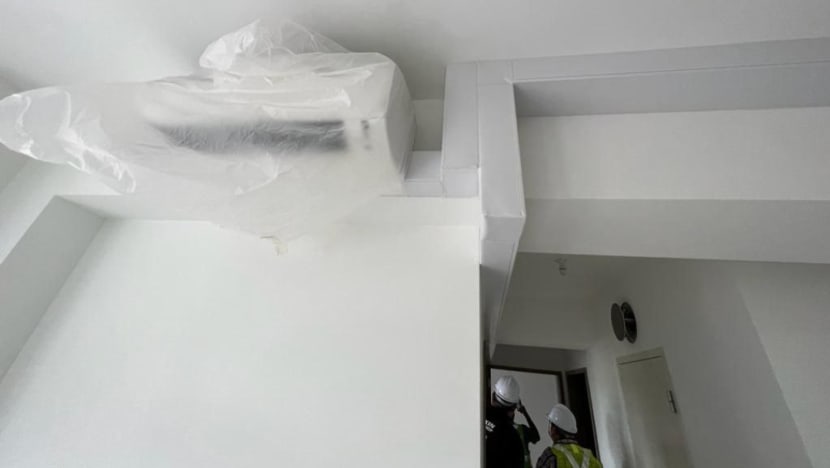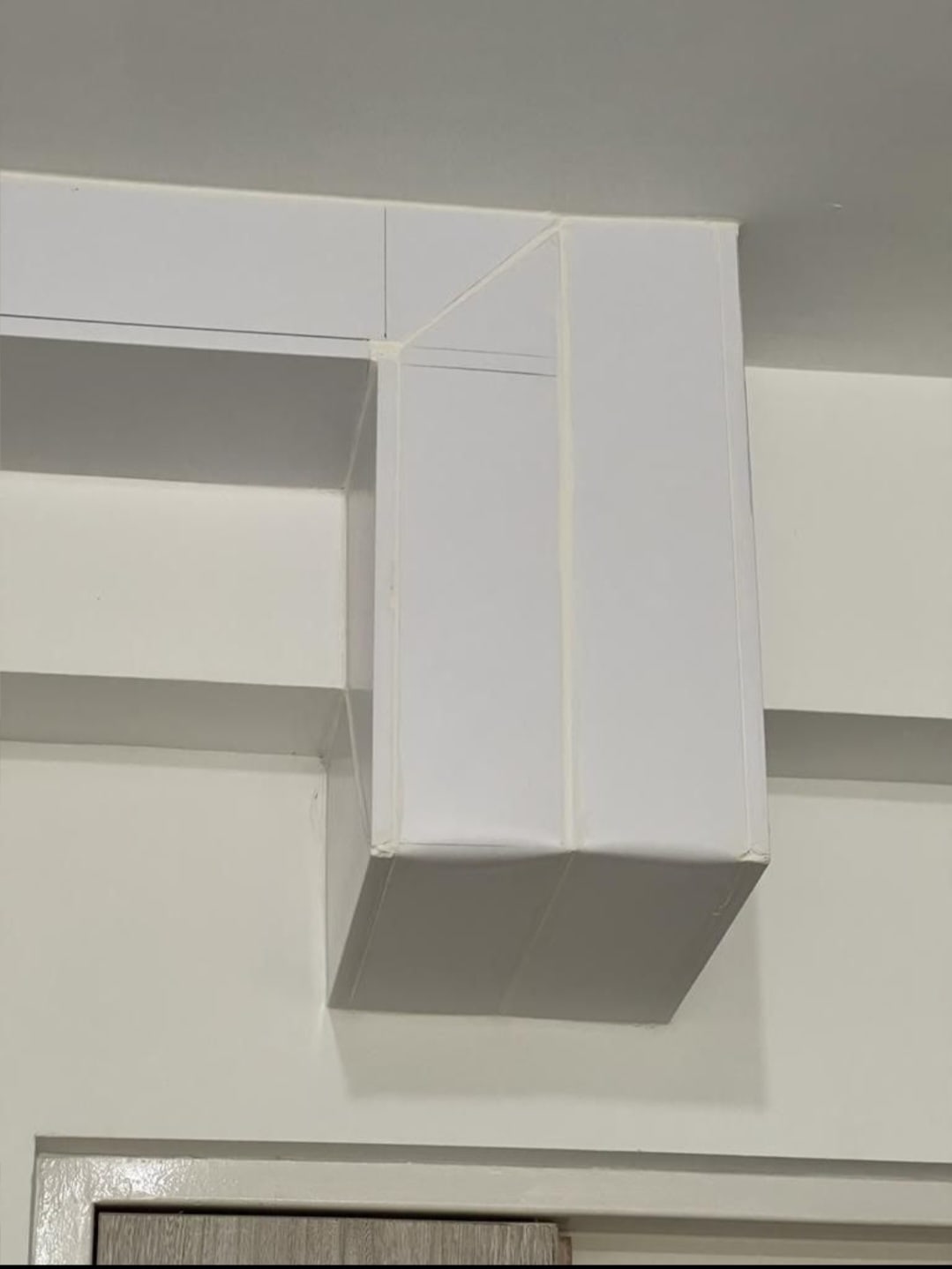'It's very ugly': Tengah flat buyers unhappy over look of centralised cooling system
Buyers of Tengah BTO flats have expressed their frustration about the trunking that conceals pipes of the centralised cooling system in their homes.

Pipes of the centralised cooling system concealed by trunking as seen in a new four-room flat in Tengah. (Photo: SP Group)
SINGAPORE: Tengah flat buyers have yet to collect their keys, but some are upset over how the centralised cooling system that will be pioneered in their homes will look.
Home owners of the new Build-to-Order (BTO) units in the west of Singapore have taken to Telegram chat groups to express their frustration over the alternative air-conditioning system, touted to be more sustainable and efficient than conventional air-conditioning.
Of the six home owners that CNA spoke to, most were dissatisfied after seeing photos of the cooling system in an unfinished flat that were circulated online.
Those photos were unauthorised and did not necessarily show the finished product, SP Group told CNA. SP Group is managing the sign-ups, installation, management and maintenance of the cooling system.
Some home owners expressed frustration with other aspects of the installation process, such as the arrangement of individual cooling units, also known as fan coil units.
Tengah, bound by Choa Chu Kang, Jurong West and Bukit Batok, was billed as Singapore's first and largest smart and sustainable town. Consisting of five districts, the town is expected to have 42,000 homes when fully developed, according to media reports in 2016 when the estate's masterplan was unveiled.
The first batch of residents is expected to collect their keys in the third quarter of this year.
The centralised cooling system was a key feature in Tengah's eco-friendly push. While the concept has been used in commercial settings, it is new to public housing and is optional for home owners. Those who prefer conventional air-conditioning units can install them instead.
Instead of using refrigerants to remove heat, the cooling system works using chilled water. Centralised chillers installed on selected housing blocks cool water, which is then ported through pipes that run through common corridors and into homes.
While conventional air-conditioning has pipes that run from indoor units to a compressor placed on a ledge outside the flat, the cooling system's pipes enter from above front doors and branch to each indoor unit.

"UGLY" TRUNKING
Residents who CNA spoke to over the past few weeks had seen leaked photos of the trunking – which conceal the cooling system's pipes – in unfinished flats and described it as "ugly".
Mock-ups and renditions of the trunking shown to them by official sources did not sway their opinions.
A home owner who wanted to be known as Mr Lim said: "I cancelled (the centralised cooling system) because I realised that it is really very unsightly." He said the trunking appeared to be double the size of conventional air-con trunking.
Another concern to the 30-year-old business owner was the configuration of the trunking.
"They run through the main door ... you can see that the trunking actually cuts through the living room and goes to the bedroom via the exterior walls of the bedroom. So that is one of the big problems."
While the trunking can be "boxed up" to make it appear part of the wall, that was not something Mr Lim wanted to do, and so he told SP Group not to proceed with the installation.
By boxing it up, "you basically enlarge the trunking", he told CNA. "And we have to pay extra for that."
Responding to CNA's queries over these concerns, SP Group took CNA through a tour of MyTengah Experience Centre at the HDB Hub earlier this month to show how the centralised cooling system works.
The trunking is about 10cm wide – 2.5cm more than that of conventional split unit air-cons – due to the thicker insulation to mitigate condensation and corrosion, according to SP Group's vice-president of sustainable energy solutions Cynthia Wong.
But at the front door inside the house, the trunking there is wider – up to 30cm, depending on the number of rooms – as it contains the main pipe supporting the entire flat.
The trunking will be painted the same colour as the walls.

Tengah flat buyers who sign up for the cooling system in advance pay 10 to 20 percent less than a home owner who signs up after collecting their keys.
For a five-room flat with five cooling units, the advance price excluding Goods and Services Tax is S$4,550 (US$3,400).
Flat buyers who sign up for the offer are given a 30-day "cooling-off period" during which they can cancel without penalty. After 30 days, they are required to pay a 35 per cent cancellation fee.
About 10,400 households have signed up as of Jun 7, Ms Wong said.
Asked how many cancelled their applications, Ms Wong said less than 0.5 per cent backed out after the cooling-off period due to various reasons, such as renovation plans that would affect the trunking or cooling unit or simply because the home owners decided they do not need air-conditioning. This number excludes those who cancel their flats.
Some home owners, though unsatisfied with the trunking, have decided against cancelling due to the hefty penalty.
One of them is a 30-year-old researcher who declined to be named.
"We were not made aware that the trunking ... was going to be jutting out along the hallway and into the living room. When we asked earlier, the salesperson kept saying it would be similar as per normal air-conditioning in current HDBs. So we went ahead since it seemed like a good choice," said the home owner, who expects to collect her keys in the first quarter of next year.
"When the pictures came out on Facebook that the trunking was going to be like that, of course most of us were not happy because we were the ones who had to bear the cost of boxing up the trunking," she added.
"I don't think we are left with much choice."

COOLING UNITS RELOCATED
Residents told CNA that a few of the cooling units were moved from the locations indicated in their contracts.
A 42-year-old home owner said SP Group told him via email in May that two of the units for his five-room flat will be placed at a different location, and gave him four days to agree to the change.
The operations executive said the SP Group email stated that the new location of the cooling units was assessed by an engineer as being "more efficient". Mr Ang was also told that if he wanted to move the unit to a location that was neither the original placement nor SP Group's suggested change, he would have to pay extra.
Like other home owners, he was also put off by the trunking.
"Imagine you walk into your house. When going in ... on top of it there is a big piping. It's very ugly."
Another home owner, Mr Ang Kok Keong, pointed out that those who have yet to engage an interior designer would have to decide on the relocation of the cooling units by themselves.
SP Group informed him via email about the change in location on Mar 29. He was given only a day to agree to the change.
"We don't get to see our flat. How would we know if the layout is okay?" the 39-year-old sales and marketing manager said.
Although the contract stated indoor unit positions were "indicative", Mr Ang said he assumed that meant home owners have the flexibility to amend the placement.
"If they are to promote the centralised cooling system, they should work with HDB and integrate the trunking into the HDB design to make it seamless," he added.
SP Group's Ms Wong said plans for the installation of the cooling units are confirmed with home owners around five-and-a-half months before the Temporary Occupation Permit is issued.
This would be around the same time home owners engaged interior designers and settled on renovation plans, she added.
Home owners are also told that piping would run in through the main door and take the shortest route to each cooling unit.
Apart from HDB regulations, SP engineers and consultants also have to consider space constraints, the possibility of condensation, the efficiency of the cooling units and airflow, Ms Wong said.
These factors may not be apparent until they conduct onsite visits, she said.
For example, a cooling unit that was originally located above the toilet door in the master bedroom had to be shifted to an adjacent wall, as the original space was too small.
In cases where the home owner insists on moving the cooling unit back to the original location, SP Group would consult HDB and its own team and reinstate the placement where possible, without additional charge. If the home owner wants to shift it elsewhere, SP Group would study its feasibility and the home owner would have to pay extra for the cost of additional materials.
HDB AWARE OF FEEDBACK
In response to queries, HDB said it was aware of the feedback from "a handful of home buyers" about the repositioning of the cooling units as well as the aesthetics of the trunking.
It added that SP Group has been in contact with the residents to address their concerns.
SP Group provides residents with mock-ups and perspectives of how the units and trunking could look like within flats "throughout the onboarding process", HDB said. It also shares interior design illustrations created using the residents' floor plans to help them visualise alternative aesthetics, such as boxing up the trunking.
"SP Group will also work with home buyers on the final positioning of their fan coil units. SP Group has shared with us that most home buyers have found this information helpful in addressing their concerns," HDB said, adding that it will continue to monitor the feedback.
Editor’s note: Changes have been made to the article to reflect SP Group’s clarifications. These include residents not having to pay a fee for moving cooling units back to original locations and that mock-ups of the units and trunking are provided to residents during the onboarding process.

















